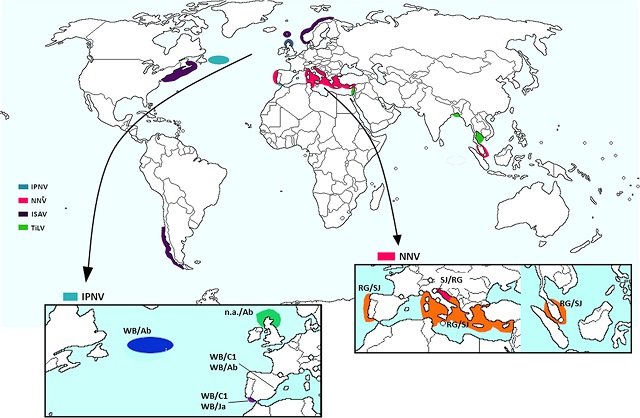
In aquaculture, infectious diseases caused by viruses are among the main causes of mortality in farmed fish.
Researchers Yulema Valero and Alberto Cuesta from the University of Murcia published a scientific review that aimed to compile the available information on reassortant viruses that affect fish species relevant to aquaculture, highlighting their potential impact for the sector.
In addition, they also report recent research advances on host-nodavirus (NNV) interaction.
Reassortant viruses
The cohabitation of different virus strains in the same geographical area opens the possibility of natural rearrangement.
Reassortant viruses is a recombination process characteristic of segmented viruses in which different viruses fuse their genome by shuffling entire segments.
This is possible when two or more viral strains coexist in a single host, increasing their probability of concatenating their viral cycles, coming to group together segments of different parental strains.
The cohabitation of different viruses in a geographic area, and therefore the possibility of natural regrouping, has been favored by the increase in the transport of eggs and larvae between facilities around the world.
Reassortant viruses in fish farming
The number of viruses that affect farmed fish is large and diverse. However, only members of four virus families incur the natural rearrangement due to the segmented genome: Birnaviridae, Nodaviridae, Orthomyxoviridae, and Amnoonviridae.
Stay Always Informed
Join our communities to instantly receive the most important news, reports, and analysis from the aquaculture industry.
Reassortant viruses have been described that show special tropisms for fish species opposite to those affected by the parental virus strains, implying an emerging threat to aquaculture but also to wild populations.
To date, outbreaks of reassortant strains of infectious pancreatic necrosis virus, nodavirus (NNV), infectious salmon anemia virus, and lake tilapia virus have been reported.
Conclusion
“Viral rearrangement is a genome recombination process exclusive to segmented viruses that inevitably marks their evolution,” they describe.
And they concluded that “In viruses that affect fish of special relevance to aquaculture, the first rearrangement events were described when the evolution of each virus began to be studied using complete sequences of each virus or, at least, using the sequence of several complete segments.
They also report that “currently, there have been outbreaks in farmed fish with four rearranged viruses: IPNV, NNV, ISAV and TiLV, the latter still emerging and partially characterized.”
According to the researchers, the appearance of rearranged viruses has given rise to the presence of lethal outbreaks in species that were previously considered asymptomatic carriers, which poses a great threat to aquaculture worldwide that could lead to greater economic losses and an unquestionable environmental impact.
“Greater efforts are absolutely necessary in the study of these strains that allow the development of preventive or palliative treatments against diseases derived from these viruses,” they concluded.
The study was funded by the State Research Agency and the Ministry of Science and Innovation.
Contact
Yulema Valero and Alberto Cuesta,
Immunobiology for Aquaculture Group,
Department of Cell Biology and Histology,
Faculty of Biology, Regional Campus of International Excellence “Campus Mare Nostrum”,
University of Murcia,
30100 Murcia, Spain.
Email: yuvalero@um.es and alcuesta@um.es
Reference (free access)
Valero, Y, Cuesta, A. Reassortant viruses threatening fish aquaculture. Rev Aquac. 2023; 1- 12. doi:10.1111/raq.12813
Editor at the digital magazine AquaHoy. He holds a degree in Aquaculture Biology from the National University of Santa (UNS) and a Master’s degree in Science and Innovation Management from the Polytechnic University of Valencia, with postgraduate diplomas in Business Innovation and Innovation Management. He possesses extensive experience in the aquaculture and fisheries sector, having led the Fisheries Innovation Unit of the National Program for Innovation in Fisheries and Aquaculture (PNIPA). He has served as a senior consultant in technology watch, an innovation project formulator and advisor, and a lecturer at UNS. He is a member of the Peruvian College of Biologists and was recognized by the World Aquaculture Society (WAS) in 2016 for his contribution to aquaculture.




